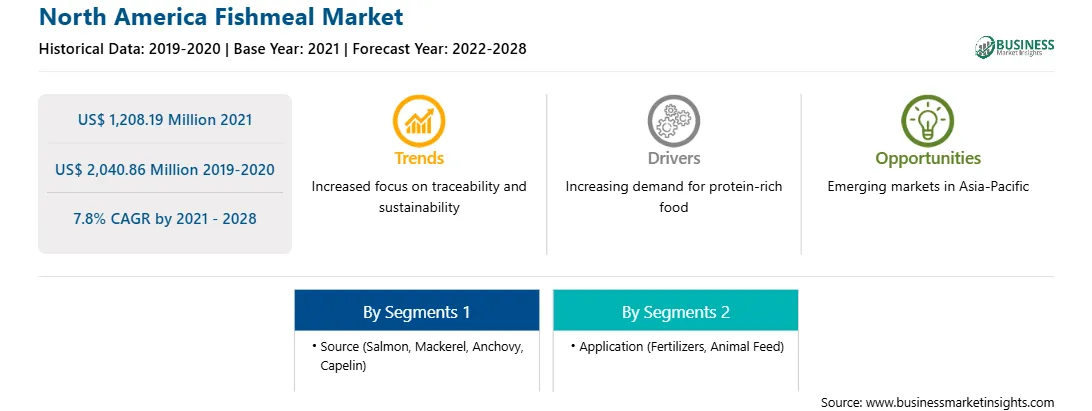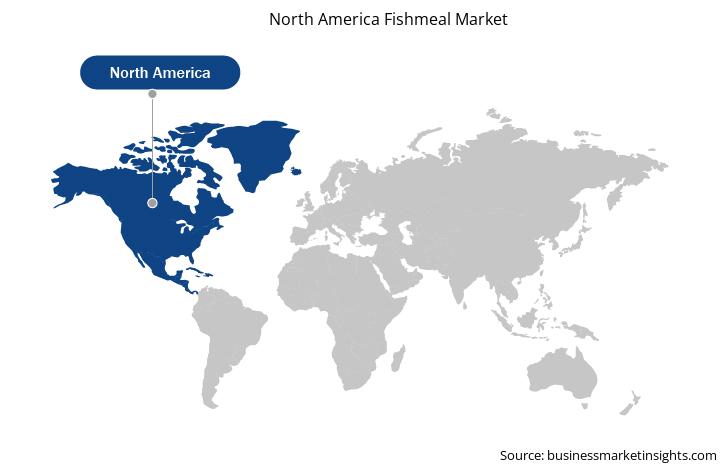The US, Canada, and Mexico are major economies in North America. Industrial livestock production has undergone substantial transformation due to technological advancements in animal vaccinations and antibiotics. According to the Food and Agriculture Organization (FAO), more than half of the world's pork and poultry, one-tenth of beef and mutton, and more than two-thirds of egg supply have originated from industrial livestock production. The development of industrial livestock production across the world has led to a significant rise in the demand for highly nutritious animal feed products. The surge in the industrial production of mutton, beef, pork, and poultry compared to grazing and mixed farming has necessitated the demand for high-grade animal feed, which, in turn, is boosting the demand for feed ingredients, including fishmeal. Fishmeal helps in enhancing feed efficiency and improving feed palatability, digestion, nutrient uptake, and absorption. Industrial livestock production has ensured a high volume of meat production at low cost by taking advantage of economies of scale. The availability of dairy and meat products at low prices has led to an increase in their consumption and thereby contributed to the growth of the industrial livestock production industry. The robust growth witnessed by the industrial livestock production sector has spurred the demand for high-quality animal feed used in rearing a range of livestock, including cattle, swine, goats, chicken, fish, and shrimps. The crucial role played by industrial livestock production in meeting the nutritional requirement of humans worldwide has led to the proliferation of industrial livestock farms across the world and augmented the sale of animal feed and its ingredients. Thus, the rise in industrial livestock production is fueling the market growth of fishmeal, as fishmeal is used as a natural protein-rich ingredient in animal feed.
As the COVID-19 outbreak affected the supply and distribution chain to a large extent, operations of various markets, including the fishmeal market, were largely affected, as it resulted in the unavailability of raw materials due to lockdown in many supplying countries.
With the new features and technologies, vendors can attract new customers and expand their footprints in emerging markets. This factor is likely to drive the North America fishmeal market. The North America fishmeal market is expected to grow at a good CAGR during the forecast period.
Strategic insights for the North America Fishmeal provides data-driven analysis of the industry landscape, including current trends, key players, and regional nuances. These insights offer actionable recommendations, enabling readers to differentiate themselves from competitors by identifying untapped segments or developing unique value propositions. Leveraging data analytics, these insights help industry players anticipate the market shifts, whether investors, manufacturers, or other stakeholders. A future-oriented perspective is essential, helping stakeholders anticipate market shifts and position themselves for long-term success in this dynamic region. Ultimately, effective strategic insights empower readers to make informed decisions that drive profitability and achieve their business objectives within the market.

| Report Attribute | Details |
|---|---|
| Market size in 2021 | US$ 1,208.19 Million |
| Market Size by 2028 | US$ 2,040.86 Million |
| Global CAGR (2021 - 2028) | 7.8% |
| Historical Data | 2019-2020 |
| Forecast period | 2022-2028 |
| Segments Covered |
By Source
|
| Regions and Countries Covered | North America
|
| Market leaders and key company profiles |
The geographic scope of the North America Fishmeal refers to the specific areas in which a business operates and competes. Understanding local distinctions, such as diverse consumer preferences (e.g., demand for specific plug types or battery backup durations), varying economic conditions, and regulatory environments, is crucial for tailoring strategies to specific markets. Businesses can expand their reach by identifying underserved areas or adapting their offerings to meet local demands. A clear market focus allows for more effective resource allocation, targeted marketing campaigns, and better positioning against local competitors, ultimately driving growth in those targeted areas.

The North America Fishmeal Market is valued at US$ 1,208.19 Million in 2021, it is projected to reach US$ 2,040.86 Million by 2028.
As per our report North America Fishmeal Market, the market size is valued at US$ 1,208.19 Million in 2021, projecting it to reach US$ 2,040.86 Million by 2028. This translates to a CAGR of approximately 7.8% during the forecast period.
The North America Fishmeal Market report typically cover these key segments-
The historic period, base year, and forecast period can vary slightly depending on the specific market research report. However, for the North America Fishmeal Market report:
The North America Fishmeal Market is populated by several key players, each contributing to its growth and innovation. Some of the major players include:
The North America Fishmeal Market report is valuable for diverse stakeholders, including:
Essentially, anyone involved in or considering involvement in the North America Fishmeal Market value chain can benefit from the information contained in a comprehensive market report.